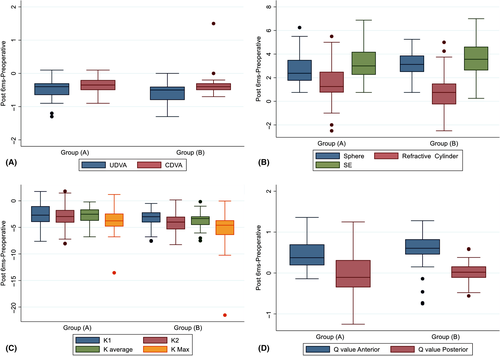Purpose
To compare the efficacy of implanting a single Keraring segment according to a novel Q‐value‐based nomogram (QN) to that of segment implantation according to the manufacturer's standard nomogram (SN), for keratoconus treatment.
Methods
This was a prospective, randomized controlled trial of 104 patients (104 eyes) with Amsler‐Krumeich grade 1 or 2 keratoconus, and type 1 or 2 cone asymmetry determined according to manufacturer's classification. They were randomly distributed into two groups: group A patients (n = 52) underwent Keraring implantation according to the SN, and group B patients (n = 52) underwent implantation of a single (210° arc‐length) Keraring segment according to the QN. Both treatments were combined with accelerated transepithelial cross‐linking, and follow‐up was 6 months. Main outcome measures were preoperative and postoperative visual acuity, subjective refraction and corneal topography.
Results
At postoperative month 6, group B exhibited statistically significantly higher values of mean uncorrected distance visual acuity (UDVA), sphere, K2, K‐average, K‐max and Q‐anterior (p = 0.02, 0.01, 0.002, 0.001, 0.0001 and 0.03, respectively) compared to that of group A. However, group A exhibited better refractive cylindrical improvements (p = 0.04). In group A, we documented spontaneous extrusion of one Keraring segment.
Conclusion
Single 210° arc‐length segment implantation using our objective QN was more efficacious for keratoconus treatment than using the subjective SN. The nomograms were comparable when the Q‐anterior value was >−1.00; however, the QN was superior to the SN when the Q‐anterior value was ≤−1.00. The QN yielded greater postoperative UDVA and smoother corneal remodelling than did the SN for treatment of grade 1 and 2 keratoconic eyes.


